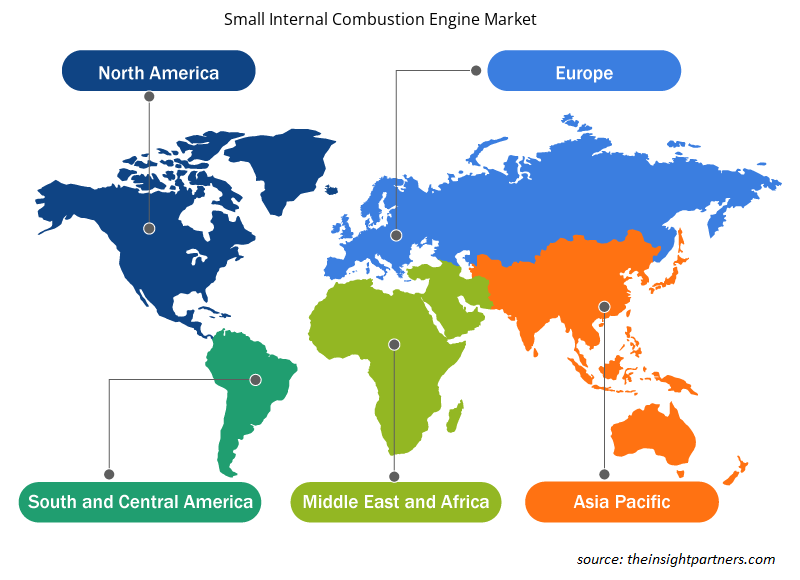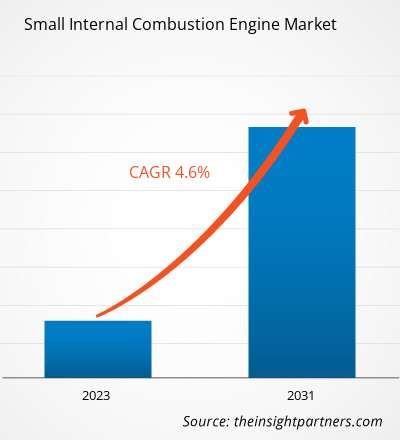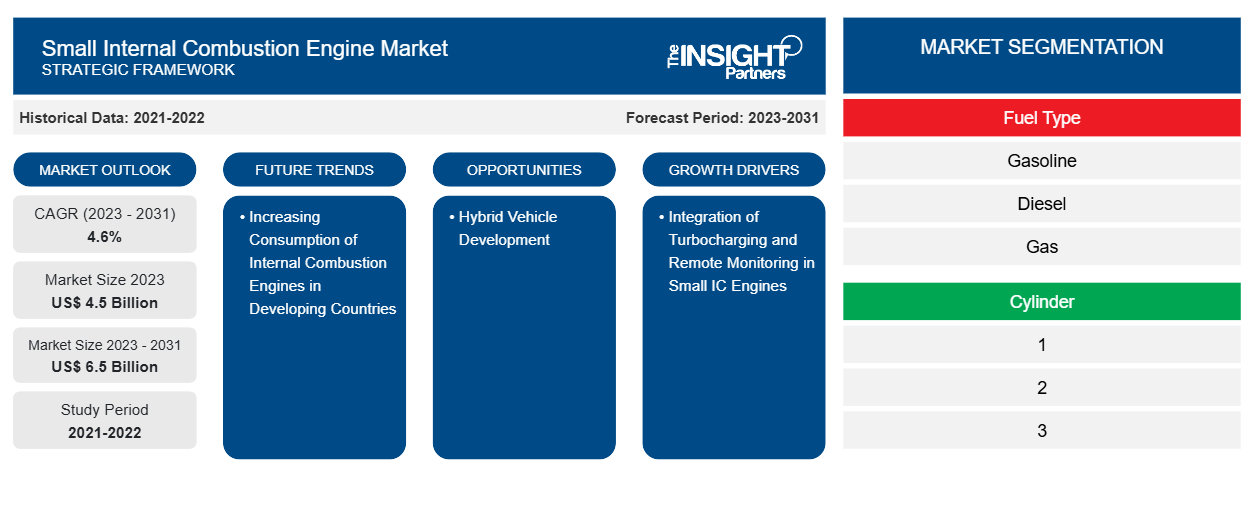من المتوقع أن يصل حجم سوق محركات الاحتراق الداخلي الصغيرة إلى 6.5 مليار دولار أمريكي بحلول عام 2031 من 4.5 مليار دولار أمريكي في عام 2023. ومن المتوقع أن ينمو السوق بمعدل نمو سنوي مركب قدره 4.6٪ في الفترة 2023-2031. إن الاعتماد المتزايد على محركات الاحتراق الداخلي الصغيرة في التطبيقات الزراعية والسكنية والبناء يغذي نمو سوق محركات الاحتراق الداخلي الصغيرة العالمية.
تحليل سوق محركات الاحتراق الداخلي الصغيرة
إن الطلب المتزايد على المحركات الموفرة للوقود والتي تنبعث منها كميات قليلة من التلوث لتقليل كمية التلوث من الهواء يدفع نمو السوق. إن ظهور المحركات الكهربائية في النقل والسيارات والتطبيقات الصناعية الأخرى في السوق العالمية هو أحد العوامل الصعبة التي تعيق نمو السوق. على الرغم من محركات الاحتراق الداخلي الصغيرة، لا تزال هناك فرصة للحفاظ على النمو فيما يتعلق بكفاءتها المحسنة في استهلاك الوقود. يتم تلبية الطلب المتزايد على تصغير معدات الطاقة لتحسين المساحة والتصميم بمحركات الاحتراق الداخلي الصغيرة.
نظرة عامة على سوق محركات الاحتراق الداخلي الصغيرة
يتم توليد الطاقة بواسطة محركات الاحتراق الداخلي الصغيرة من خلال أنواع مختلفة من الوقود، مثل الديزل والبنزين والغاز. يتمتع كل وقود بمجموعة محددة من الخصائص - مثل الكثافة والتقلب - والتي تستمد استخدامها في التطبيق المطلوب. تُفضل المحركات التي تعمل بالديزل للتطبيقات الثقيلة أو حيث تكون متطلبات الطاقة عالية. في المقابل، فإن محركات الاحتراق الداخلي الصغيرة التي تعمل بالبنزين أقل ضرراً بالبيئة لأنها تنتج انبعاثات منخفضة مقارنة بغيرها. إن استخدام الغاز الطبيعي في تكنولوجيا احتراق المحركات الصغيرة لديه القدرة على حل مشاكل الانبعاثات العالية وسيساعد الشركات المصنعة على تلبية المعايير التنظيمية الجديدة. هناك زيادة في اعتماد محركات الاحتراق الداخلي الصغيرة في أمريكا الجنوبية وآسيا وأفريقيا، بينما ستتجه أمريكا الشمالية وأوروبا نحو المحركات الكهربائية خلال فترة التنبؤ.
قم بتخصيص هذا التقرير ليناسب متطلباتك
ستحصل على تخصيص لأي تقرير - مجانًا - بما في ذلك أجزاء من هذا التقرير، أو تحليل على مستوى الدولة، وحزمة بيانات Excel، بالإضافة إلى الاستفادة من العروض والخصومات الرائعة للشركات الناشئة والجامعات
-
احصل على أهم اتجاهات السوق الرئيسية لهذا التقرير.ستتضمن هذه العينة المجانية تحليلاً للبيانات، بدءًا من اتجاهات السوق وحتى التقديرات والتوقعات.
محركات الاحتراق الداخلي الصغيرة والعوامل المحفزة والفرص المتاحة في السوق
تزايد استهلاك محركات الاحتراق الداخلي في البلدان النامية
تعتمد الدول النامية، بما في ذلك الهند والصين وكوريا الجنوبية والبرازيل، بشكل أكبر على الوقود الأحفوري لتوليد الكهرباء والسيارات والتصنيع والنقل وغيرها من القطاعات. إن الزيادة السكانية ونقص تطوير البنية الأساسية للتكنولوجيات الكهربائية هي العوامل الرئيسية التي تدعم سوق محركات الاحتراق الداخلي الصغيرة. لا تزال المحركات الكهربائية والأجهزة التي تعمل بالطاقة الكهربائية والسيارات أكثر تكلفة بالنسبة للعملاء من محركات الاحتراق الداخلي. ونتيجة لذلك، نظرًا لقيود الأسعار، لا تنفذ الدول أي حظر على محركات الاحتراق الداخلي، مما يدعم نمو السوق.
تتحسن معايير الانبعاثات لمحركات الاحتراق الداخلي الصغيرة التي يعمل المصنعون على تحسين الحل لها. وفقًا لبيانات مجموعة البنك الدولي بشأن الوصول إلى الكهرباء، في جنوب آسيا، يتمتع حوالي 91.6٪ من السكان بالقدرة على الوصول إلى الكهرباء. علاوة على ذلك، يتزايد استهلاك الكهرباء للاستخدامات الأساسية في البلدان - مثل الصين والهند - مع زيادة عدد السكان، بسبب استخدام البلدان للوقود الأحفوري لتوليد الكهرباء. ومن المتوقع أن تخلق هذه الهيمنة القوية لمحركات الاحتراق الداخلي (IC) في المناطق النامية فرصة لسوق محركات الاحتراق الداخلي الصغيرة لتقديم حلول متقدمة. على سبيل المثال، وفقًا لشركة Bosch Ltd، فإن أكثر من 80٪ من المركبات المباعة في الهند بحلول عام 2030 ستكون مدعومة بمحركات الاحتراق الداخلي (IC). إن اعتماد المناطق النامية على الوقود الأحفوري ومحركات الاحتراق الداخلي (IC) يمثل فرصة نمو قوية لسوق محركات الاحتراق الداخلي الصغيرة.
دمج الشحن التوربيني والمراقبة عن بعد في محركات الاحتراق الداخلي الصغيرة
تُستخدم تقنية الشحن التوربيني بالفعل في محركات الاحتراق الداخلي (IC) في المركبات الآلية لتعزيز سعة الطاقة للمحركات متوسطة القدرة. وتبحث شركات تصنيع محركات الاحتراق الداخلي الصغيرة في اعتماد تقنية الشحن التوربيني، وخاصة متطلبات المحركات الصغيرة. ومن المتوقع أن يتم تقديم تقنية الشحن التوربيني لمضخات المياه وعربات الريكشا وماكينات جز العشب ومعدات تنسيق الحدائق والمولدات والجرارات خلال فترة التنبؤ. ومن المفترض أن توفر تقنية الشحن التوربيني ناتج طاقة محدد أكبر بنسبة 40-60% في المحركات ذات السعة الأصغر. ومن المتوقع أن يؤدي هذا التكامل للشواحن التوربينية في محركات الاحتراق الداخلي الصغيرة إلى خلق اتجاه جديد للسوق في السنوات القادمة.
علاوة على ذلك، مع تزايد الرقمنة في كل قطاع صناعي تقريبًا، يتطور سوق محركات الاحتراق الداخلي الصغيرة أيضًا مع الاتصال الرقمي. على سبيل المثال، تقدم Briggs & Stratton, LLC مولدًا من سلسلة Elite بقوة 8 كيلو وات مع اتصال Bluetooth والمراقبة عن بعد من خلال الهاتف المحمول. يتميز بتقنية InfoHub Portable Power، التي توفر مراقبة عن بعد للمولدات المحمولة المجهزة بمحركات احتراق داخلي صغيرة. تعمل خيارات الاتصال هذه على تعزيز واجهة المستخدم والآلة، مما قد يخلق اتجاهًا جديدًا في السوق.
تقرير تحليل تجزئة سوق محركات الاحتراق الداخلي الصغيرة
إن القطاعات الرئيسية التي ساهمت في اشتقاق تحليل سوق محرك الاحتراق الداخلي الصغير هي الوقود والأسطوانة وناتج الطاقة والمستخدم النهائي.
- بناءً على نوع الوقود، تم تقسيم سوق محركات الاحتراق الداخلي الصغيرة إلى البنزين والديزل والغاز (CNG وLPG وLNG). احتل قطاع البنزين حصة سوقية أكبر في عام 2023.
- على أساس الأسطوانة، تم تقسيم سوق محرك الاحتراق الداخلي الصغير إلى 1 و2 و3 و4. احتفظ قطاع الأسطوانة الواحدة بحصة سوقية أكبر في عام 2023.
- على أساس إنتاج الطاقة، تم تقسيم السوق إلى 1-5 كيلو واط، 6-10 كيلو واط، 11-20 كيلو واط. سيطر قطاع 11-20 كيلو واط على السوق في عام 2023.
- بناءً على المستخدم النهائي، تم تقسيم السوق إلى توليد الطاقة والتصنيع والنفط والغاز والنقل وغيرها. احتل قطاع النقل حصة سوقية أكبر في عام 2023.
تحليل حصة سوق محركات الاحتراق الداخلي الصغيرة حسب المنطقة الجغرافية
ينقسم النطاق الجغرافي لتقرير سوق محرك الاحتراق الداخلي الصغير بشكل أساسي إلى خمس مناطق: أمريكا الشمالية وأوروبا وآسيا والمحيط الهادئ والشرق الأوسط وأفريقيا وأمريكا الجنوبية.
ستهيمن منطقة آسيا والمحيط الهادئ على سوق محركات الاحتراق الداخلي الصغيرة في عام 2023. تعد الهند والصين من الدول الرائدة في تصنيع محركات الاحتراق الداخلي في منطقة آسيا والمحيط الهادئ. يؤدي ارتفاع الدخل المتاح في البلدان النامية، وخاصة في الهند والصين، إلى قاعدة عملاء كبيرة لمحركات الاحتراق الداخلي الصغيرة، مثل مولدات الطاقة والمحركات الصناعية والدراجات ذات العجلتين والأدوات الكهربائية، مما يدفع نمو سوق محركات الاحتراق الداخلي الصغيرة. تعد الصين مركز تصنيع رائد لمحركات الاحتراق الداخلي، في حين تعتبر الهند واليابان أيضًا مساهمين مهمين في النمو الإقليمي.
تتميز بلدان منطقة آسيا والمحيط الهادئ المختلفة بالإنتاج الضخم لمحركات الاحتراق الداخلي الصغيرة المطلوبة للتصنيع وتوليد الطاقة والآلات الصناعية الأخرى . إن العدد المتزايد من شركات التصنيع في الهند والصين، بسبب التوافر القوي للموارد البشرية الماهرة، يدفع نمو سوق محركات الاحتراق الداخلي الصغيرة. كما أن الزيادة في مبيعات المركبات ذات العجلتين والتقدم في مصادر وقود المحرك يدعمان نمو السوق. وعلاوة على ذلك، نظرًا للزيادة السكانية في المنطقة والقدرات الاقتصادية المنخفضة نسبيًا لمختلف الدول، فقد عزز ذلك اعتماد محركات الاحتراق الداخلي بدلاً من الطاقة الكهربائية.
رؤى إقليمية حول سوق محركات الاحتراق الداخلي الصغيرة
لقد قام المحللون في Insight Partners بشرح الاتجاهات والعوامل الإقليمية المؤثرة على سوق محركات الاحتراق الداخلي الصغيرة طوال فترة التوقعات بشكل شامل. يناقش هذا القسم أيضًا قطاعات سوق محركات الاحتراق الداخلي الصغيرة والجغرافيا في جميع أنحاء أمريكا الشمالية وأوروبا ومنطقة آسيا والمحيط الهادئ والشرق الأوسط وأفريقيا وأمريكا الجنوبية والوسطى.

- احصل على البيانات الإقليمية المحددة لسوق محركات الاحتراق الداخلي الصغيرة
نطاق تقرير سوق محركات الاحتراق الداخلي الصغيرة
| سمة التقرير | تفاصيل |
|---|---|
| حجم السوق في عام 2023 | 4.5 مليار دولار أمريكي |
| حجم السوق بحلول عام 2031 | 6.5 مليار دولار أمريكي |
| معدل النمو السنوي المركب العالمي (2023 - 2031) | 4.6% |
| البيانات التاريخية | 2021-2022 |
| فترة التنبؤ | 2023-2031 |
| القطاعات المغطاة |
حسب نوع الوقود
|
| المناطق والدول المغطاة |
أمريكا الشمالية
|
| قادة السوق وملفات تعريف الشركات الرئيسية |
|
كثافة اللاعبين في سوق محركات الاحتراق الداخلي الصغيرة: فهم تأثيرها على ديناميكيات الأعمال
يشهد سوق محركات الاحتراق الداخلي الصغيرة نموًا سريعًا، مدفوعًا بالطلب المتزايد من المستخدم النهائي بسبب عوامل مثل تفضيلات المستهلك المتطورة والتقدم التكنولوجي والوعي المتزايد بفوائد المنتج. ومع ارتفاع الطلب، تعمل الشركات على توسيع عروضها والابتكار لتلبية احتياجات المستهلكين والاستفادة من الاتجاهات الناشئة، مما يؤدي إلى زيادة نمو السوق.
تشير كثافة اللاعبين في السوق إلى توزيع الشركات أو المؤسسات العاملة في سوق أو صناعة معينة. وهي تشير إلى عدد المنافسين (اللاعبين في السوق) الموجودين في مساحة سوق معينة نسبة إلى حجمها أو قيمتها السوقية الإجمالية.
الشركات الرئيسية العاملة في سوق محركات الاحتراق الداخلي الصغيرة هي:
- شركة كاتربيلر
- شركة كاواساكي للصناعات الثقيلة المحدودة
- شركة ميتسوبيشي للصناعات الثقيلة المحدودة
- ليبهر
- شركة يانمار القابضة
- المحدودة
إخلاء المسؤولية : الشركات المذكورة أعلاه ليست مرتبة بأي ترتيب معين.

- احصل على نظرة عامة على أهم اللاعبين الرئيسيين في سوق محركات الاحتراق الداخلي الصغيرة
أخبار سوق محركات الاحتراق الداخلي الصغيرة والتطورات الأخيرة
يتم تقييم سوق محركات الاحتراق الداخلي الصغيرة من خلال جمع البيانات النوعية والكمية بعد البحث الأولي والثانوي، والتي تتضمن منشورات الشركات المهمة وبيانات الجمعيات وقواعد البيانات. فيما يلي قائمة بالتطورات في سوق محركات الاحتراق الداخلي الصغيرة والاستراتيجيات:
- في مارس 2023، أنشأت شركة Tata Cummins Green Energy Solutions مصنعًا لتصنيع محركات الهيدروجين ICE للسيارات التجارية المتوسطة والثقيلة. سيعزز هذا المرفق مكانة الشركة وحضورها في السوق الهندية.
- في يناير 2021، وقعت شركة كاتربيلر مارين صفقة لتوريد محركات بحرية لأسطول البحرية الأمريكية الجديد المكون من ستة قاطرات من فئة YT 808.
تقرير سوق محركات الاحتراق الداخلي الصغيرة: التغطية والنتائج المتوقعة
يوفر تقرير "حجم سوق محرك الاحتراق الداخلي الصغير والتوقعات (2021-2031)" تحليلاً مفصلاً للسوق يغطي المجالات التالية:
- حجم السوق والتوقعات على المستويات العالمية والإقليمية والوطنية لجميع قطاعات السوق الرئيسية التي يغطيها النطاق
- ديناميكيات السوق مثل المحركات والقيود والفرص الرئيسية
- الاتجاهات المستقبلية الرئيسية
- تحليل مفصل لقوى بورتر الخمس
- تحليل السوق العالمي والإقليمي الذي يغطي اتجاهات السوق الرئيسية واللاعبين الرئيسيين واللوائح والتطورات الأخيرة في السوق
- تحليل المشهد الصناعي والمنافسة الذي يغطي تركيز السوق، وتحليل خريطة الحرارة، واللاعبين البارزين، والتطورات الأخيرة
- ملفات تعريف تفصيلية للشركة مع تحليل SWOT
- التحليل التاريخي (سنتان)، سنة الأساس، التوقعات (7 سنوات) مع معدل النمو السنوي المركب
- تحليل PEST و SWOT
- حجم السوق والقيمة / الحجم - عالمي، إقليمي، بلد
- الصناعة والمنافسة
- مجموعة بيانات إكسل
التقارير الحديثة
شهادات العملاء
سبب الشراء
- اتخاذ قرارات مدروسة
- فهم ديناميكيات السوق
- تحليل المنافسة
- رؤى العملاء
- توقعات السوق
- تخفيف المخاطر
- التخطيط الاستراتيجي
- مبررات الاستثمار
- تحديد الأسواق الناشئة
- تحسين استراتيجيات التسويق
- تعزيز الكفاءة التشغيلية
- مواكبة التوجهات التنظيمية























 احصل على عينة مجانية ل - سوق محركات الاحتراق الداخلي الصغيرة
احصل على عينة مجانية ل - سوق محركات الاحتراق الداخلي الصغيرة